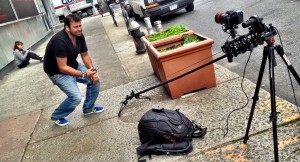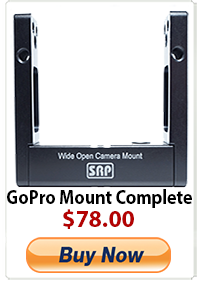High-Speed & Time-Lapse.
High-speed and time-lapse are sort of the opposite but make a great pair to write about. One is hundreds of stills recorded per second and the other is generally one frame per second or longer. I chose to write about both as both are of great interest to me.
I have had a lot of opportunity to shoot with high-speed cameras for well over a decade now with my first experience being on a Photo-Sonics ActionMaster 16mm which shot film at 500fps using 400′ mags. It only gave you about 30 seconds per mag but at the time there wasn’t any other way to shoot high-speed outside of film. Since that time I have been blessed to use other high-speed cameras from companies like RedLake, Teledyne, Vision Research, Fastec Imaging, etc. I have also had the opportunity to train people on the Phantom Flex and Fastec TS3Cine which has been a great experience to show everyone just how easy it is to use.
Basically the way true high-speed cameras work is they use a buffer system that is RAM based that you trigger to record an event. This event is temporary and then needs to be told where its permanent home is. Usually the camera will have a built in or removable storage system that you then dump that event to. You also have the option of sending that event out of the cameras video output (HD-SDI or HDMI) to go to an external recorder. Ideally you want to take the event that is recorded (an image stack) and go to the built in or removable storage on the camera in a RAW format or the highest quality setting you can. If you keep the group of stills (image stack) intact as stills you have greater flexibility in post production to then change the video frame-rate, adjust color temp, etc. So for example if you are shooting with a Phantom Flex for a commercial or feature, you would want to take the .cine files and use Glue Tools software to convert the files, etc. If you shoot with the TS3Cine ideally you would dump from the buffer in the camera to the built in SSD as Cinema DNG RAW files (DNG image stack). You would then take those files into After Effects, Resolve, etc to leverage your image as best possible. The Sony NEX-FS700U handles high-speed in a different way. Instead of giving you an image stack or RAW .Cine, etc files you get an AVCHD file that is whatever frame rate you set the camera to (example 23.98, 29.97, etc) Once the frame rate is selected you cannot change it later in post and the video is baked if you will, meaning it is what it is. AVCHD does not correct in post as well as a RAW file, but the FS700 is a great option for lower budgets that do not require a specialized camera. I was able to use and shoot with the FS700 last week and played with the 240, 480 and 960fps frame rates. 240fps looked very good and was 1080p but 480 and 960 use line skipping and doubling from much lower resolutions to achieve these speeds. This works much like the Casio cameras but at a better quality level. Weiscam HS2, Phantom Flex (Miro, Gold, 65, etc), and Fastec cameras all use their native resolutions throughout their frame rates and do not use line skipping and doubling to achieve their frame rates. This means there is no interpolation or artifact and they maintain the details in the image. One thing that the FS700 does have over them is that it is a day to day use camera which these are not. All these cameras have their pros and cons and I am glad that there is high-speed for every budget. I will not get into if high-speed is overused or will become “tired” etc as the audience will judge what is done with these cameras. I suspect there will be hundreds of face slapping videos coming out when the F700 is released to the public but have a feeling that will go away quickly and cool content will follow.
Time-lapse. I got into time-lapse at the beginning of this year, when everyone said it was done to death. I had all the gear, the motion control, etc to make a great time-lapse but was stuck in 24fps and high-speed doing commercial work, marketing videos, etc. I missed out on what some say was a trend and overdone, etc. Me not caring decided I would learn time-lapse while others focused on high-speed. In my early 20’s I had done a few stop-go claymations shot on a Bolex and with super 8 cameras like the Canon 814, Braun Nizo’s, etc. I had always loved animation and the idea of capturing a subject at 1 or 2fps instead of 24 or 30 had always been appealing. You can make the most ordinary subject come to life when shot at one frame at a time over an expanded period. I have always loved photography so time-lapse and stop motion always felt natural. Having had a 5DMKII since it was available I am amazed I had not tried it before. Its a lot of work but well worth the reward in the end. I think because it is tedious that many avoid it or dislike it. Spending 15 minutes to a full day to capture a 30 second event requires major dedication and most of all patience.
Mid last year I had seen a few videos from experts like Tom Lowe of www.Timescapes.org , Shawn Reeder, Preston Kanak, Philip Bloom, Eric Hines, Steve Bumgardner and Tyler Ginter to name a few so I decided to use the equipment I already owned and finally just do it. I did a simple test but decided if I was going to shoot time-lapse I might as well go big or go home so I hatched a plan to shoot a project that would require several months and seasons to complete. This is how the idea for Operation Origami was born. I have been working on this project with my girlfriend Heather @miss_h_bomb for the past five months using motion control by Kessler Crane (Stealth, Philip Bloom Pocket Dolly, the Shuttle Pod). For cameras we have decided to go a little traditional and non-traditional using most of what is currently in the market today. Outside of the obvious Canon 5DMKII and MKIII we have used the C300, F3, FS100, Go Pro Hero 2, Arri Alexa, XF105, AF100, Epic X, etc. For locations we have shot in NYC, Vegas, Boston, NH and are shooting a scene in LA. From city streets to mountain tops and ocean sides, its been a project of the heart which is why I do not care if time-lapse is considered passe, etc. I have learned a lot about lenses, camera motion from a frame at a time point of view, and more importantly about being prepared and the art of patience. What these guys (time-lapse shooters) do is amazing and keeps me in a state of wonderment.
High-speed and time-lapse are both great additives to standard cinematography. They also stand on their own and with the right artist behind the story, directing, cinematography, editing and color they can make for some fascinating works of art. I will continue to use both regardless of what others say. Be true and focus on what you want to do and show. Personally I can’t get enough of either.
Mike Sutton @MNS1974
p.s. Full disclosure, I work for a company that sells both the TS3Cine, Sony FS700U, and Canon line. We also rent the Phantom Flex and Alexa Plus with 120fps option so I am biased.












Pingback: High-Speed & Time-Lapse. | Brinno Blog